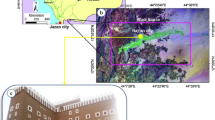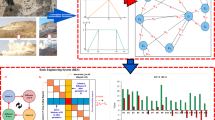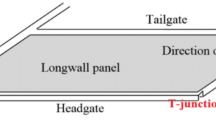Abstract
Plastic zones evaluation around the powerhouse caverns is a very crucial issue in designing and constructing these structures and accurate determination of their related optimum support systems. Due to inherent difficulties during the field measurement of plastic zones around the powerhouse caverns and shortcomings of the available methods in this field, applying new predictive models is an attractive and helpful topic. Accordingly, plastic zones around the powerhouse caverns have been investigated in this research using numerical analysis (NA), fuzzy inference system (FIS) and multivariate regression (MVR) model. Based on the numerical simulations, a new predictive equation has been developed to determine the plastic zone at middle point of sidewall and induced key point around a cavern. The basic parameters including rock geomechanical properties and geometrical characteristics of cavern structures have been considered as input variables in plastic zones modeling at middle points of roof, floor, left sidewall and right sidewall as well as at key point. For FIS and MVR models construction, sufficient datasets were introduced based on the numerical simulations. Performance of established models has been assessed applying testing dataset and utilizing powerful statistical indices. Accordingly, it is proved that the derived results from FIS and NA models are more precise than MVR model and they are more satisfactory in plastic zone estimation. Finally, parametric study results revealed that lateral stress coefficient, depth of overburden and rock mass rating are the most effectual parameters and tensile strength is the least influencing parameter on the plastic zone around a cavern.










Similar content being viewed by others
References
Zhu WS, Sui B, Li XJ, Li SC, Wang WT (2008) A methodology for studying the high wall displacement of large scale underground cavern complexes and it’s applications. Tunn Undergr Sp Technol 23(6):651–664
Chong L, Jinhai X, Jianzhong P, Chao M (2012) Plastic zone distribution laws and its types of surrounding rock in large-span roadway. Int J Min Sci Technol 22(1):23–28
Feng W, Huang R, Li T (2012) Deformation analysis of a soft–hard rock contact zone surrounding a tunnel. Tunn Undergr Sp Technol 32:190–197
Xiang Y, Feng S (2013) Theoretical prediction of the potential plastic zone of shallow tunneling in vicinity of pile foundation in soils. Tunn Undergr Sp Technol 38:115–121
Zhang W, Goh ATC (2014) Multivariate adaptive regression splines model for reliability assessment of serviceability limit state of twin caverns. Geomech Eng 7(4):431–458
Chen YF, Zheng HK, Wang M, Hong JM, Zhou CB (2015) Excavation-induced relaxation effects and hydraulic conductivity variations in the surrounding rocks of a large-scale underground powerhouse cavern system. Tunn Undergr Sp Technol 49:253–267
Yu S, Zhu WS, Yang WM, Zhang DF, Ma QS (2015) Rock Bridge fracture model and stability analysis of surrounding rock in underground cavern group. Struct Eng Mech 53(3):481–495
Zhang W, Goh ATC (2016) Predictive models of ultimate and serviceability performances for underground twin caverns. Geomech Eng 10(2):175–188
Zhang QB, He L, Zhu WS (2016) Displacement measurement techniques and numerical verification in 3D geomechanical model tests of an underground cavern group. Tunn Undergr Sp Technol 56:54–64
Li HB, Yang XG, Zhang XB, Zhou JW (2017) Deformation and failure analyses of large underground caverns during construction of the Houziyan Hydropower Station, Southwest China. Eng Fail Anal 80:164–185
Jiang Q, Su G, Feng XT, Chen G, Zhang MZ, Liu C (2018) Excavation optimization and stability analysis for large underground caverns under high geostress: a case study of the Chinese Laxiwa project. Rock Mech Rock Eng 52(3):1–21
Behnia M, Cheraghi Seifabad M (2018) Stability analysis and optimization of the support system of an underground powerhouse cavern considering rock mass variability. Environ Earth Sci 77:645. https://doi.org/10.1007/s12665-018-7835-2
Gao X, Chuan Yan E, Jim Yeh TC, Cai JS, Liang Y, Wang M (2018) A geostatistical inverse approach to characterize the spatial distribution of deformability and shear strength of rock mass around an unlined rock cavern. Eng Geol 245(1):106–119
Li X, Chen HM, Sun Y, Zhou R, Wang L (2018) Study on the splitting failure of the surrounding rock of underground caverns. Geomech Eng 14(5):499–507
Xua MF, Wu SC, Gao YT, Ma J, Wu QL (2019) Analytical elastic stress solution and plastic zone estimation for a pressure relief circular tunnel using complex variable methods. Tunn Undergr Sp Technol 84:381–398
Wang M, Li HB, Han JQ, Xiao XH, Zhou JW (2019) Large deformation evolution and failure mechanism analysis of the multi-freeface surrounding rock mass in the Baihetan underground powerhouse. Eng Fail Anal 100:214–226
Ren Q, Xu L, Zhu A, Shan M, Zhang L, Gu J, Shen L (2019) Comprehensive safety evaluation method of surrounding rock during underground cavern construction. Undergr Sp. https://doi.org/10.1016/j.undsp.2019.10.003
Li B, Xu N, Dai F, Zhang G, Xiao P (2019) Dynamic analysis of rock mass deformation in large underground caverns considering microseismic data. Int J Rock Mech Min Sci 122:104078. https://doi.org/10.1016/j.ijrmms.2019.104078
Monjezi M, Rezaei M, Yazdyan Varjani A (2009) Prediction of rock fragmentation due to blasting in Gol-E-Gohar iron mine using fuzzy logic. Int J Rock Mech Min Sci 46(8):1273–1280
Monjezi M, Rezaei M, Yazdyan A (2010) Prediction of backbreak in open-pit blasting using fuzzy set theory. Expert Syst Appl 37(3):2637–2643
Monjezi M, Rezaei M (2011) Developing a new fuzzy model to predict burden from rock geomechanical properties. Expert Syst Appl 38(3):9266–9273
Rezaei M, Yazdyan Monjezi M, Varjani A (2011) Development of a fuzzy model to predict flyrock in surface mining. Saf Sci 49(2):298–305
Rezaei M, Majdi A, Monjezi M (2014) An intelligent approach to predict unconfined compressive strength of rock surrounding access tunnels in longwall coal mining. Neural Comput Appl 24(1):233–241
Rezaei M, Asadizadeh M, Hossaini MF, Majdi A (2015) Prediction of representative deformation modulus of longwall panel roof rock strata using Mamdani fuzzy system. Int J Min Sci Technol 25(1):23–30
Rezaei M (2018) Indirect measurement of the elastic modulus of intact rocks using the Mamdani fuzzy inference system. Measurement 129:319–331
Rezaei M (2019) Forecasting the stress concentration coefficient around the mined panel using soft computing methodology. Eng Comput 35(2):451–466
Liu C, Gu C, Chen B (2017) Zoned elasticity modulus inversion analysis method of a high arch dam based on unconstrained lagrange support vector regression (support vector regression arch dam). Eng Comput 33(3):443–456
Shirani Faradonbeh R, Taheri A (2019) Long-term prediction of rockburst hazard in deep underground openings using three robust data mining techniques. Eng Comput 35(2):659–675
Ghasemi E, Gholizadeh H, Adoko AC (2019) Evaluation of rockburst occurrence and intensity in underground structures using decision tree approach. Eng Comput. https://doi.org/10.1007/s00366-018-00695-9
Rezaei M, Asadizadeh M (2019) Predicting unconfined compressive strength of intact rock using new hybrid intelligent models. J Min Environ. https://doi.org/10.22044/jme.2019.8839.1774
Liao CP (1993) Fuzzy influence function method for calculating mine subsidence in a horizontal seam. Geotech Geol Eng 11(4):235–247
Li W, Mei S, Zai S, Zhao S, Liang X (2006) Fuzzy models for analysis of rock mass displacements due to underground mining in mountainous areas. Int J Rock Mech Min Sci 43(4):503–511
Rezaei M, Rajabi M (2018) Vertical displacement estimation in roof and floor of an underground powerhouse cavern. Eng Fail Anal 90:290–309
Jing L (2003) A review of techniques advances and outstanding issues in numerical modelling for rock mechanics and rock engineering. Int J Rock Mech Min Sci 40(3):283–353
Zadeh LA (1965) Fuzzy sets. Inf Control 8(3):338–353
Mamdani EH, Assilian S (1975) An experiment in linguistic synthesis with a fuzzy logic controller. Int J Man Mach Stud 7(1):1–13
Liitiainen E, Verleysen M, Corona F, Lendasse A (2009) Residual variance estimation in machine learning. Neurocomputing 72(16–18):3692–3703
Hoek E, Carranza-Torres C, Corkum B (2002) Hoek–Brown failure criterion 2002 edition. In: Proceedings of the 5th North American Rock Mechanics Symposium, Toronto, July, pp 267–273
Rajabi M, Rahmannejad R, Rezaei M, Ganjalipour K (2017) Evaluation of the maximum horizontal displacement around the power station caverns using artificial neural network. Tunn Undergr Sp Technol 64:51–60
Zhu WS, Li XJ, Zhang QB, Zheng WH, Xin XL, Sun AH, Li SC (2010) A study on sidewall displacement prediction and stability evaluations for large underground power station caverns. Int J Rock Mech Min Sci 47(7):1055–1062
Abdollahipour A, Rahmannejad R (2013) Investigating the effects of lateral stress to vertical stress ratios and caverns shape on the cavern stability and sidewall displacements. Arabian J Geosci 6(12):4811–4819
Liu J, Zhao XD, Zhang SJ, Xie LK (2018) Analysis of support requirements for underground water-sealed oil storage cavern in China. Tunn Undergr Sp Technol 71:36–46
Sopacı E, Akgün H (2008) Engineering geological investigations and the preliminary support design for the proposed Ordu Peripheral Highway Tunnel, Ordu, Turkey. Eng Geol 96(1–2):43–61
Sinotech Engineering Consultants Inc (1999) Design of large underground caverns—a case history based on the Mingtan Pumped Storage Project in Taiwan. Geotech Geol Eng 23:175–197
Hosseinitoudeshki V (2013) Numerical analysis of K0 to tunnels in rock masses exhibiting strain-softening behaviour (case study in Sardasht dam tunnel, NW Iran). Int Res J Basic Appl Sci 4(6):1572–1581
Panda MK, Mohanty S, Pingua BMP, Mishra AK (2014) Engineering geological and geotechnical investigations along the head race tunnel in Teesta Stage-III hydroelectric project, India. Eng Geol 181(1):297–308
Rezaei M, Hossaini MF, Majdi A (2015) Development of a time-dependent energy model to calculate the mining-induced stress over gates and pillars. J Rock Mech Geotech Eng 7(3):306–317
Rezaei M (2018) Long-term stability analysis of goaf area in longwall mining using minimum potential energy theory. J Min Environ 9(1):169–182
Rezaei M, Farouq Hossaini M, Majdi A, Najmoddini I (2018) Study the roof behavior over the longwall gob in long-term condition. J Geol Min Res 10(2):15–27
Khoshjavan S, Mazlumi M, Rezai B, Rezai M (2010) Estimation of hardgrove grindability index (HGI) based on the coal chemical properties using artificial neural networks. Orient J Chem 26(4):1271–1280
Sayadi AR, Tavassoli SMM, Monjezi M, Rezaei M (2014) Application of neural networks to predict net present value in mining projects. Arabian J Geosci 7(3):1067–1072
Majdi A, Rezaei M (2013) Application of artificial neural networks for predicting the height of destressed zone above the mined panel in longwall coal mining. In: 47th U.S. Rock Mechanics/Geomechanics Symposium, San Francisco, June, pp 1665–1673
Rezaei M, Hossaini MF, Majdi A, Najmoddini I (2017) Determination of the height of destressed zone above the mined panel: an ANN model. Int J Min Geo-Eng 51(1):1–7
Rezaei M (2017) Feasibility of novel techniques to predict the elastic modulus of rocks based on the laboratory data. Int J Geotech Eng. https://doi.org/10.1080/19386362.2017.1397873
Rezaei M (2018) Development of an intelligent model to estimate the height of caving–fracturing zone over the longwall gobs. Neural Comput Appl 30(7):2145–2158
Nikafshan Rad H, Hasanipanah M, Rezaei M, Lotfi Eghlim A (2018) Developing a least squares support vector machine for estimating the blast-induced flyrock. Eng Comput 34(4):709–717
Asadizadeh M, Rezaei M (2019) Surveying the mechanical response of nonpersistent jointed slabs subjected to compressive axial loading utilising GEP approach. Int J Geotech Eng. https://doi.org/10.1080/19386362.2019.1596610
Author information
Authors and Affiliations
Corresponding author
Ethics declarations
Conflict of interest
All of the authors have declared that no conflict of interest is encompassed for the current research.
Additional information
Publisher's Note
Springer Nature remains neutral with regard to jurisdictional claims in published maps and institutional affiliations.
Electronic supplementary material
Below is the link to the electronic supplementary material.
Rights and permissions
About this article
Cite this article
Rezaei, M., Rajabi, M. Assessment of plastic zones surrounding the power station cavern using numerical, fuzzy and statistical models. Engineering with Computers 37, 1499–1518 (2021). https://doi.org/10.1007/s00366-019-00900-3
Received:
Accepted:
Published:
Issue Date:
DOI: https://doi.org/10.1007/s00366-019-00900-3




